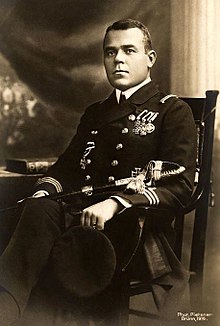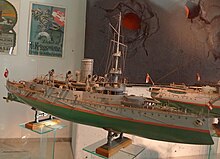Rudolf Singule
Rudolf Singule (* 8. April 1883 in Pola , † 2. May 1945 in Brno ) was a submarine commander in the First and Second World War and one of the few Maria Theresa Ritter from the ranks of the Imperial and Royal Navy Austria-Hungary .
Life
Austro-Hungarian Navy
Singule was born in Pola as the son of a Brno factory worker Rudolf Singule, who worked as a naval commissariat adjunct in Pola. He joined the Austrian Navy on June 28, 1901, graduated from the Naval Academy Fiume in what is now Rijeka and was promoted to midshipman 2nd class after successfully completing it . He then served first on the Budapest liner , later on the small cruiser Aspern and finally on the Vienna liner . In 1909 he was transferred to the newly established submarine base in Pola as a frigate lieutenant , where he was promoted to lieutenant of the line on May 1, 1911 . On September 21, 1912, he became the commander of the SMU 4 submarine , which was built for the Austrian Navy at the Germania shipyard in Kiel and which he commanded until July 7, 1913. He then served again at the submarine base in Pola.
On April 9, 1915, he took over the submarine SMU 4 for a second time , with which he became one of the most successful submarine commanders in the Kuk Navy. He was first known for his successful attack on June 9, 1915 on the British cruiser Dublin off the Albanian coast. Singule torpedoed the cruiser, which remained operational enough to march back to Brindisi , but then had to be moved to Great Britain for repairs . Singule's greatest success was the sinking of the Italian armored cruiser Giuseppe Garibaldi off Dubrovnik on the morning of July 18, 1915. Thereafter, until November 1918, the Italian navy refrained from any major action against the then Austro-Hungarian coast. In mid-May 1917, SMU 4 took part in the attack on the Otranto barrier , and in the same month the boat sank the Italian troop carrier Perseo . Overall, Singule achieved the following successes with SMU 4 :
- 15 merchant ships sunk with a total of 15,450 GRT
- 1 armored cruiser sunk with 7,234 tons
- 2 merchant ships damaged with a total of 3,535 GRT
- 1 light cruiser damaged with 5,400 tons
- 2 merchant ships captured as prizes
On November 30, 1917 Singule was transferred back to the submarine base in Pola, where he led torpedo courses on the training ship Panther until the end of the war .

For his success as a submarine commander, the Chapter of the Military Maria Theresa Order awarded him the first gold medal for bravery for officers . After submitting further documents, this was revoked and instead he was awarded the Knight's Cross of the Military Maria Theresa Order on December 21, 1929 as the 194th bearer . This also included the elevation to the personal baron class by the exiled ore house, which was no longer legally effective since the end of the Kuk monarchy .
After the war, Singule worked for a pension insurance company in Brno.
Second World War
In 1939, after the beginning of the Second World War , he was reactivated by the German Navy with the rank of lieutenant commander and served in Italy and Kiel . From October 16, 1941 to April 29, 1942 he was in the 5th U-Flotilla in command of the formerly Dutch submarine UD 4 , which carried out training tasks in the Baltic Sea . On February 1, 1942, he was promoted to corvette captain. When he reached his 60th birthday, he was released from service.
family
His wife Dora b. Schneider (* 1887), with whom he was married from 1911, died in Brno in 1940. The marriage had three daughters, Martha (* Pola 1913), Anna (* Pola 1914) and Elisabeth (* Brno 1920). In 1943 Singule married Margarethe von Brausewetter for the second time.
Death and posthumous honor
Rudolf Singule was murdered on May 2, 1945 in Brno by a presumably drunk Soviet soldier while he was trying to protect an unknown woman from assault on the street. He was informally buried on May 4th in an unlabeled grave next to his first wife. On March 30, 1983, his remains were moved to the grave of relatives of one of his daughters on the occasion of a planned but not carried out road widening. His name was still not allowed to appear on his grave.
On November 11, 2006, a commemoration ceremony for Rudolf Singule took place at the Brno Central Cemetery ( Ústřední hřbitov ) at the instigation of the Brno City Rifle Corps ( Brnenský mestský strelecký sbor ). His grave is now near the restored military department in the Brno Central Cemetery, group 58, corner grave no.72.
Awards
- Knight's Cross of the Military Maria Theresa Order
- Knight's Cross of the Leopold Order with war decoration and swords
- Order of the Iron Crown 3rd class with war decorations and swords
- Military Merit Cross 3rd Class with War Decoration and Swords
- Military Merit Medal in Silver with War Decoration and Swords
- Military Merit Medal in bronze with war decoration and swords
- Karl-Troop Cross
- Military anniversary cross
- Iron Cross 1st and 2nd class (German Empire)
Individual evidence
- ↑ “Unveiling of the grave slab for Rudolf von Singule”, in Brünner Heimatbote , vol. 59, issue 1–2, January-February 2007, Schwäbisch Gmünd (pp. 15–18) ( Memento of the original from December 29, 2009 in the Internet Archive ) Info: The archive link was inserted automatically and has not yet been checked. Please check the original and archive link according to the instructions and then remove this notice. (PDF; 1.3 MB)
Web links
- http://www.marineverband.at/veranstaltungen/singule.htm
- http://www.uboat.net/wwi/men/commanders/536.html
- http://www.histomar.net/GSM/htm/singule.htm
- Corvette captain Rudolf von Singule from Brno. (PDF; 1.3 MB) In: Brno Heimatbote. Vol. 59, issue 1–2, January – February 2007, Schwäbisch Gmünd, pp. 19–20.
literature
- The Austria-Hungary submarines. ADEVA, Graz 1981, ISBN 3-201-01151-7 .
- Register of Austro-Hungarian warships, from Abbondanza to Zrinyi. NWV, Vienna 2002, ISBN 3-7083-0052-1 .
- The Austro-Hungarian U-Boat Ace Rudolf Singule and SM U-IV. and The last Knight Supplement - Rudolf Singule. In: Jak P. Mallmann Showell (Ed.): U-boat archive: early journals reprinted. Military Press, Milton Keynes, Buckinghamshire, UK 2004, ISBN 0-85420-104-1 . (The U-Boat Archive Series, Volume 6)
| personal data | |
|---|---|
| SURNAME | Singule, Rudolf |
| BRIEF DESCRIPTION | Austrian submarine commander |
| DATE OF BIRTH | April 8, 1883 |
| PLACE OF BIRTH | Pola |
| DATE OF DEATH | May 2, 1945 |
| Place of death | Brno |

